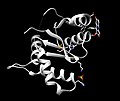Integrase: Difference between revisions
CSV import |
CSV import |
||
| Line 24: | Line 24: | ||
[[Category:HIV/AIDS]] | [[Category:HIV/AIDS]] | ||
{{stub}} | {{stub}} | ||
<gallery> | |||
File:PDB_1wjd_EBI.jpg|Structure of HIV-1 integrase catalytic core domain | |||
File:PDB_1c1a_EBI.jpg|Crystal structure of HIV-1 integrase | |||
File:PDB_1c1a_EBI.jpg|Crystal structure of HIV-1 integrase | |||
File:The_actual_HIV_integrase.jpg|Integrase | |||
</gallery> | |||
Revision as of 04:52, 18 February 2025
Integrase is an enzyme produced by a retrovirus that enables its genetic material to be integrated into the DNA of the infected cell. This enzyme is a key component in the lifecycle of retroviruses and is a target for antiretroviral drugs used to treat HIV.
Function
Integrase is a vital enzyme in the lifecycle of a retrovirus. After the retrovirus has entered a cell, it uses its own reverse transcriptase enzyme to produce DNA from its RNA genome. The newly produced DNA is then integrated into the host cell's genome by the integrase enzyme, allowing the retrovirus to permanently infect the host cell and replicate.
Structure
The structure of integrase varies among different retroviruses, but all integrases share a common core domain that contains the active site of the enzyme. This core domain is responsible for the catalytic activities of the enzyme, including the cleavage of the viral DNA ends and the joining of the viral and host DNA.
Inhibition
Inhibition of integrase is a strategy for treating retroviral infections, including HIV. Integrase inhibitors are a class of antiretroviral drugs that block the action of integrase, preventing the virus from integrating its genetic material into the host cell's DNA. This stops the virus from replicating and spreading to other cells.





